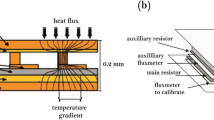Abstract
A multi-field coupled model was developed to simulate the flow–compaction behavior of thick composite laminates manufactured by the autoclave process based on Darcy’s law and the effective compaction stress theory. The model was verified by comparing the predictions with the experiment results of a thick unidirectional laminate. The results show that the resin flow and compaction of fiber bed start from the top surface and gradually spread into the interior region, and the non-uniform resin flow along the thickness direction causes a gradient distribution of fiber volume fraction in the thick composite part. A cross-plied composite laminate model with a thin interlaminar layer was constructed, and the effect of the interlaminar transverse permeability on the flow–compaction behavior of the thick cross-plied laminate was numerically analyzed. The results indicate that the thick cross-plied composite laminate with high interlaminar transverse permeability has the similar flow–compaction process with that of the thick unidirectional laminate. An interlaminar layer with low transverse permeability impedes the resin flowing out from the interior of the thick cross-plied composite laminate and causes a lower fiber volume fraction compared with that in a unidirectional laminate.











Similar content being viewed by others
References
Bogetti TA, Gillespie JJW (1992) Process-induced stress and deformation in thick-section thermoset composite laminates. J Compos Mater 26:626–660
Shin DD, Hahn HT (2004) Compaction of thick composites: simulation and experiment. Polym Compos 25:49–59
Springer GS (1982) Resin flow during the cure of fiber reinforced composites. J Compos Mater 16:400–410
Loos AC, Springer GS (1983) Curing of epoxy matrix composites. J Compos Mater 17:135–169
Gutowski TG, Morigaki T, Cai Z (1987) The consolidation of laminate composites. J Compos Mater 21:172–188
Gutowski TG, Cai Z, Bauer S, Boucher D, Kingery J, Wineman S (1987) Consolidation experiments for laminate composites. J Compos Mater 21:650–657
Dave R, Kardos JL, Duduković MP (1987) A model for resin flow during composite processing: part 1—general mathematical development. Polym Compos 8:29–38
Dave R, Kardos JL, Duduković MP (1987) A model for resin flow during composite processing part 1: numerical analysis for unidirectional graphite/epoxy laminates. Polym Compos 8:123–132
Dave R (1990) A unified approach to modeling resin flow during composite processing. J Compos Mater 24:22–41
Smith GD, Poursartip A (1993) A comparison of two resin flow models for laminate processing. J Compos Mater 27:1695–1711
Young WB (1995) Resin flow analysis in the consolidation of multi-directional laminated composites. Polym Compos 16:250–257
Young WB (1996) Consolidation and cure simulations for laminated composites. Polym Compos 17:142–148
Hubert P, Vaziri R, Poursartip A (1999) A two-dimensional flow model for the process simulation of complex shape composite laminates. Int J Numer Methods Eng 44:1–26
Hubert P, Poursartip A (2001) A method for the direct measurement of the fibre bed compaction curve of composite prepregs. Compos A 32:179–187
Costa VAF, Sousa ACM (2003) Modeling of flow and thermo-kinetics during the cure of thick laminated composites. Int J Therm Sci 42:15–22
Li Y, Li M, Gu Y, Zhang Z (2011) Numerical and experimental study of the bleeder flow in autoclave process. Appl Compos Mater 18:327–336
Ganapathi AS, Joshi SC, Chen Z (2013) Simulation of bleeder flow and curing of thick composites with pressure and temperature dependent properties. Simul Model Pract Theory 32:64–82
Lam RC, Kardos JL (1991) The permeability and compressibility of aligned and cross-plied carbon fiber beds during processing of composites. Polym Eng Sci 31:1064–1070
Li M, Gu Y, Zhang Z, Sun Z (2007) A simple method for the measurement of compaction and corresponding transverse permeability of composite prepregs. Polym Compos 28:61–70
Kim YK, White SR (1997) Viscoelastic analysis of processing-induced residual stresses in thick composite laminates. Mech Compos Mater Struct 4(4):361–387
Kim YK, White SR (1997) Process-induced stress relaxation analysis of AS4/3501-6 laminate. J Reinf Plast Compos 16:2–16
Zhang JT, Zhang M, Li SX, Pavier MJ, Smith DJ (2016) Residual stresses created during curing of a polymer matrix composite using a viscoelastic model. Compos Sci Technol 130:20–27
Behzad T, Sain M (2007) Finite element modeling of polymer curing in natural fiber reinforced composites. Compos Sci Technol 67:1666–1673
Scott EP, Beck JV (1992) Estimation of thermal properties in epoxy matrix/carbon fiber composite materials. J Compos Mater 26:132–149
Springer GS, Tsai SW (1967) Thermal conductivity of unidirectional materials. J Compos Mater 1:166–173
Lee WI, Loos AC, Springer GS (1982) Heat of reaction, degree of cure, and viscosity of hercules 3501-6 resin. J Compos Mater 16:510–520
Bogetti TA, Gillespie JW (1991) Two-dimensional cure simulation of thick thermosetting composites. J Compos Mater 25:239–273
Ding A, Li S, Wang J, Zu L (2015) A three-dimensional thermo-viscoelastic analysis of process-induced residual stress in composite laminates. Compos Struct 129:60–69
Kim KS, Hahn HT (1989) Two-dimensional cure simulation of thick thermosetting composites. Compos Sci Technol 36:121–132
Baran I, Cinar K, Ersoy N, Akkerman R, Hattel JH (2017) A review on the mechanical modeling of composite manufacturing processes. Arch Comput Methods Eng 24:365–395
Meng M, Rizvi MJ, Le HR, Grove SM (2016) 3D FEA modelling of laminated composites in bending and their failure mechanisms. Compos Struct 138:295–304
Ogihara S, Takeda N, Kobayashi A (1998) Transverse cracking in CFRP cross-ply laminates with interlaminar resin layers. Adv Compos Mater 7:347–363
Zhong Y, Joshi SC (2015) Impact behavior and damage characteristics of hygrothermally conditioned carbon epoxy composite laminates. Mater Des 65:254–264
Kardos JL, Duduković MP, Dave R (1986) Void growth and resin transport during processing of thermosetting—matrix composites. Adv Polym Sci 80:101–123
Acknowledgements
This work is supported by the Fundamental Research Funds for the Central Universities of China under Grant Nos. 2018IB003 and 2018IB004.
Author information
Authors and Affiliations
Corresponding author
Rights and permissions
About this article
Cite this article
Qiao, Y., Zhang, J., Zhang, M. et al. Numerical analysis on the flow–compaction behavior and the effect of interface permeability in thick composite plates during autoclave processing. J Mater Sci 53, 14412–14422 (2018). https://doi.org/10.1007/s10853-018-2660-2
Received:
Accepted:
Published:
Issue Date:
DOI: https://doi.org/10.1007/s10853-018-2660-2




